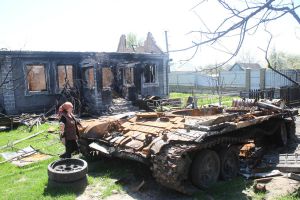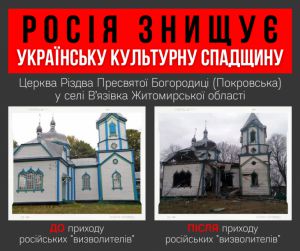Before the full-scale invasion of the forces of russian federation on the territory of sovereign Ukraine, a thousand-year-old Chernihiv, Kharkiv, Mariupol, Kherson, Irpin, Bucha, Gostomel, Volnovakha, Borodyanka were beautiful European towns with both historic and modern buildings, parks, museums, fountains on the squares. Now, their streets and entire neighborhoods remind us the episodes from the scariest movies about apocalypse.
Mariupol, most recently a flourishing town on the seashore in Donetsk region is now scaring the people with the images of dead ones lying on the streets after bombardments and large-scale destruction. Now the city with 500,000 residents does not have a single building intact. Deputy mayor Serhiy Orlov claims that 80 to 90 percent of infrastructure is destroyed. On March 15 alone, Russian aviation conducted 22 air raids and dropped 100 bombs on the city. On March 16, the bastards dropped a 1000-kilogram bomb on Mariupol dramatic theater, where hundreds of people with children were hiding in basements. They also attacked Neptune pool, where the locals took cover. A satellite observed the word “CHILDREN” written next to the dramatic theatre building, but it didn’t stop Russian pilot who acted as a killer.
On March 20, Russian occupants dropped a bomb on the building of arts school on Mariupol’s left bank, where 400 people were hiding. Russian aviation landed a direct hit on Mariupol maternity home, killing three people, including a little girl. 17 people were wounded. Later, a pregnant woman deceased from injuries; her unborn child could not be saved, too.
As of March 13, the total number of those who died in Mariupol made 2,338. These are the ones whose bodies were found on the streets. At the same time, the number of those remaining under the debris is still unknown. The dead ones are buried in common graves or in the yards; 70 percent of them can be identified.
Russian aircraft bombed Azovstal, the giant industrial enterprise. Mariupol that has been encircled by Russian troops for 25 days now suffers from shelling and bombardments. Serhiy Orlov reports that the search and rescue crews cannot approach the fire to take it away because their cars were destroyed during the attacks; besides, they have no fuel. The city is out of water, medications and food. The people received the water from emptied heating batteries, take the water from puddles. They melted the snow when it was there. Russian occupants do not let the humanitarian convoys in.
The town of Volnovakha in Donetsk region is actually gone. The infrastructure of this district center where 100,000 people used to live before the war is now completely destroyed by air raids and artillery shelling. Most of the population is evacuated via humanitarian corridors.
For 25 consecutive days, enemy artillery and aviation have been landing adjusted fire on residential neighborhoods of one million-strong Kharkiv city. At least 600 multi-story buildings were destroyed. Cruise missiles downed the building of Kharkiv regional administration in the city’s historical center. The buildings of Kharkiv town hall, national university named after Vasyl Karazin, Uspensky cathedral and other shrines, the Hall of Labor (erected in 1916), the Academy of Management, some 50 schools and seven hospitals – all of these were damaged. A Museum of Fine Arts did not make it, too; however, the masterpieces from it were saved. The staff managed to save the pictures of Ivan Aivazovsky, Illya Repin (specifically his legendary painting called “Reply of the Zaporozhian Cossacks”), and the works of Taras Shevchenko. The level of destruction in the city that resists the occupants is still extremely high; even if there’s enough money to rebuild it from scratch, it will take years.
The ancient city of Chernihiv is on the brink of humanitarian catastrophe because of the constant intensive shooting. The city suffers from air raids, as the enemy planes drop FAB-500 on residential quarters (these are the unguided bombs dropped from high altitude). Residential houses, hospitals, schools, the Chernihiv Polytehcnical Institute are destroyed. Vasyl Tarnovsky’s Museum of Ukrainian Antiquities, built in the 19th century, is leveled to the ground. According to the local government’s estimates, the damage that is currently done to the city amounts to 10 billion dollars. More than 200 peaceful residents deceased over 20 days in Chernihiv. They are buried in trenches. The death rate among the people with chronic diseases has increased four times compared to the pre-war period; the city is left without water, electricity, and it suffers from trouble with food and medication supplies. Mayor Vladyslav Atroshchenko reiterates that during the WWII, German Nazis erased the city from the face of the Earth. “And now, the Russian fascists commit this crime again”, he says.
Irpin, Bucha and Vorzel are empty; almost all locals left the destroyed towns in Kyiv region. Most of them will have nowhere to return. In Luhansk region, there’s not a single settlement that would have left intact after the attacks of the Russian army.





